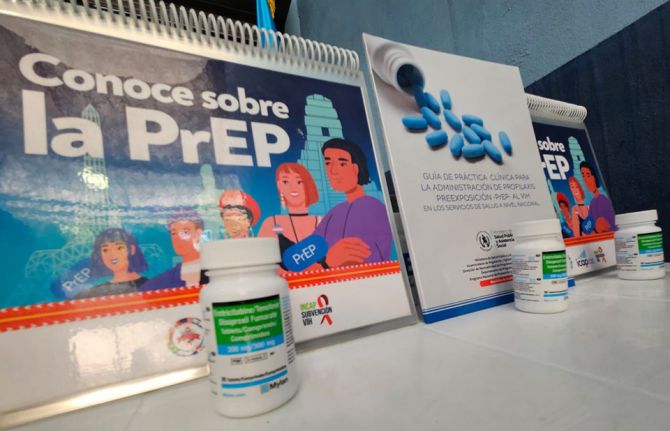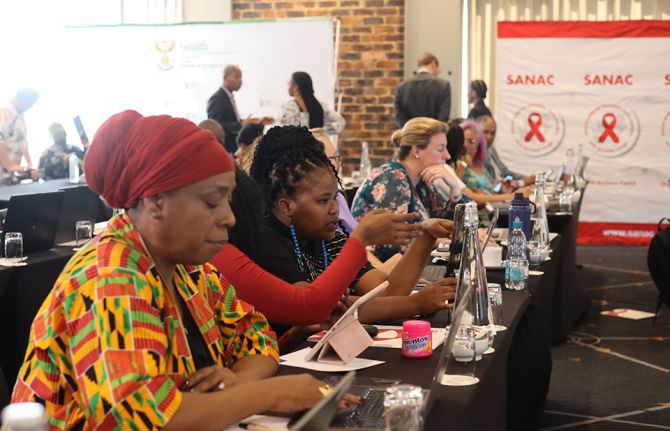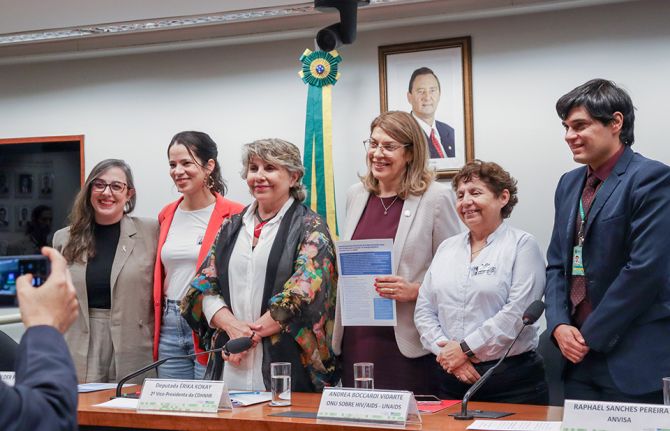
Feature Story
Preventing HIV, preserving the environment
01 July 2008
01 July 2008 01 July 2008
The condoms factory uses natural latex
collected by local rubber tappers and it
will be able to supply the Brazilian
government with 100 million condoms a
year. Photo credit: UNAIDS/J.Spaull
The use of condoms in Brazil is preventing the spread of HIV and it might also be helping to save the rainforest thanks to a condom factory opened in April in the Amazon region. This unique factory uses natural latex collected by local rubber tappers and it will be able to supply the Brazilian government with 100 million condoms a year.
The company which runs the factory – Natex - is a joint venture between the local state of Acre, the Ministry of the Environment and the Ministry of Health. It represents Acre’s new vision for the Amazon - “Florestania” - which seeks to increase the living standards of its inhabitants whilst also preserving the rain forest, through increasing the value of the products extracted from it.
The factory is located in Xapuri, made famous by the environmentalist and rubber tapper Chico Mendes who was assassinated there twenty years ago, and it is a direct legacy of his life’s work. Threatened with the destruction of their livelihood by the cattle ranchers who were clearing the forest, Mendes’s great achievement was to forge an alliance between the interests of the rubber tappers and the environmentalists. Mendes saw the rubber tappers as the natural custodians of the forest.
The factory provides employment for around 100 people and the latex is supplied by around 700 rubber tappers. As well as payment for the latex, the rubber tappers receive a fee for “environmental services”, recognising their importance in safeguarding the forest. This has greatly improved the living conditions of rubber tappers such as Chico Mendes’s cousin Sebastiao Teixeira Mendes who gets a guaranteed income for his latex which is higher than he could get elsewhere. He sees the rubber tappers as the “soldiers of the forest – patrolling and managing the forest”.
At the opening of Natex, the then Minister of Environment Marina Silva - the daughter of rubber tappers herself – was in no doubt of the significance of the factory: “This is a project where high technology will help to preserve the soul of the forest”. Adding, “The forest will remain the forest and the rubber tappers will remain rubber tappers through a new way of working and producing”.
As well as the environmental and social aspects of the factory, the other main driver of the project has been the Government’s need for an increasing supply of good quality condoms. The distribution of free condoms coupled with a national campaign for their usage has been at the core of the Brazilian Governments AIDS prevention strategy.

The distribution of free condoms coupled
with a national campaign for their usage
has been at the core of the Brazilian
Governments AIDS prevention strategy.
Photo credit: UNAIDS/J.Spaull
Since 1994, 1.5 billion free condoms have been distributed and it is projected that 557 million will be distributed this year reaching out to 52% of the population. The change in people’s attitudes can be seen from a national study, which showed that the percentage of those who used condoms during their first sexual encounter rose from 10% in 1986 to 47.8% in 1998 and 65.8% in 2005. In another study in 2004 showed that 96% of the adult population cited the use of condoms as the best method of preventing HIV transmission.
In 2007, the Government of Brazil imported one billion condoms and plans to purchase an additional 1.2 billion by the end of the year. It is expected that the factory will eventually increase its annual production from 100 to 200 million condoms and diversify into female condoms, therefore greatly reducing the Government’s reliance on importing condoms.
Whilst the condoms will be slightly more expensive to produce than importing from Asia, it is a cost that the director of the National AIDS Programme Dr Mariangela Simao believes is well worth paying as it “reflects the social benefits of increasing the income of the autochthonous population and a sustainable way of managing the native rubber trees”.
UNAIDS Country Director Mr Pedro Chequer, who was previously the National AIDS Director and as such was involved in the planning stages for the factory believes that it “represents the Government’s high level political commitment to maintain HIV as a priority agenda for the Country”. The world, he notes, faces a huge shortage of condoms. “As far as male condoms are concerned the annual deficit would be around 30 billion if we consider half of the world male population using a condom once a week. Of course the initial production of 100 million condoms will not have much affect on the world scenario, but it will help the country have guaranteed access to the production of condoms”.
It is a model that he believes Brazil could export through joint ventures with other Latin American Countries.
Sebastiao Mendes and the local community have a name for Natex that sums up how they feel about the factory - “The love factory”. It is easy to see why there is such enthusiasm for the factory - a factory that is helping in the response to AIDS, but also helping to improve the living conditions of the local population whilst at the same time preserving the endangered rain forest.
Preventing HIV, preserving the environment
Feature stories:
Brazilian designer: condoms, basic as jeans, necessary as love (16 March 2006)




